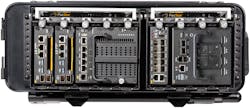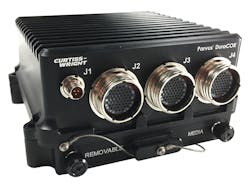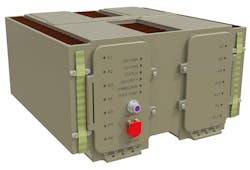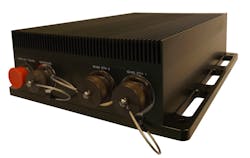Rugged computing takes on the battlefield networking challenge
NASHUA, N.H. - Warfighters and the experts that support them have a dizzying amount of computing power thanks to small, rugged mobile computers designed for the modern battlefield. Today’s forward-deployed rugged computers, servers, and network equipment also need to have security at top priorities.
Aneesh Kothari, the vice president of marketing for Systel Inc. in Sugar Land, Texas, says the military’s focus on Joint All-Domain Command and Control (JADC2) connectivity is a large trend, as the military-aerospace rugged computing sector rolls into the year 2022. The goal of JADC2 is to share data in all domains across all branches, quickly and securely.
According to the nonpartisan Congressional Research Service in Washington, “traditionally, each of the military services developed its own tactical network that was incompatible with those of other services (i.e., Army networks were unable to interface with Navy or Air Force networks). DOD [Department of Defense] officials have argued that future conflicts may require decisions to be made within hours, minutes, or potentially seconds compared with the current multiday process to analyze the operating environment and issue commands.”
Dominic Perez, technical fellow and chief technical officer of Curtiss-Wright Defense Solutions, says he agrees that JADC2 is the biggest programmatic driver of trends in small rugged computers and network equipment for aerospace and defense electronics, including the U.S. Air and Space Force’s Advanced Battle Management System (ABMS).
“Underneath JADC2 is ABMS, project convergence, and project overmatch,” Perez says. “The military is recognizing the need to share data across domains, top to bottom, left to right. That’s going to necessitate, in particular, more edge processing, but also more processing in just about any environment you can conceive of.
Compute power
Perez continues, “The other driver we’re seeing is on the technical front. There is more compute power than ever in small form factor systems. Just half a decade ago, you were looking at a very high-powered system with maybe four cores and 32 Gigs of RAM. And now, routinely, in a 2.5-pound package, we’re deploying 16 cores and 128 Gigs of RAM. This allows more complex, more compute intensive applications to be pushed out to the tactical edge.
“These technical drivers work hand-in-hand with the programmatic drivers,” Perez says. “You can want and proscribe anything at the programmatic level, but if theSystel’s Kothari says that Edge AI capabilities and high-speed secure networking are “vital for mission success. As the drive towards JADC2 and multi-domain operations progresses across all service branches, compute and connectivity are critical. On the hardware side, this translates to requirements for higher performance systems in smaller form factors.”
Justin Moll, the vice president of sales and marketing for Pixus Technologies USA in Tonawanda, N.Y., says that “lines are blurring” between the traditional radio frequency (RF) and sensor domain and the processing domain.
“We are seeing a shift in the types of enclosure systems for military vehicles and command posts,” Moll says. “While there is growth in multi-function, multi-purpose solutions, the space constraints remain compact. A mix of next-generation purpose-built enclosure systems and multi-function designs are emerging.”
Open standards
The DOD has long been pushing for vendor-agnostic components through open standards programs like Sensor Open Systems Architecture (SOSA) and Modular Open Systems Approach (MOSA). The latter system is the largest trend driving development in the rugged computing sector, says Jason DeChiaro, systems architect at Curtiss Wright Defense Solutions.
“MOSA is real: not only has it been made law by Congress, the House Armed Services Committee is extremely interested and supportive, asking the Army to implement it and calling it out in a number of reports,” DeChiaro says. “The secretaries of the Army, Navy and Air Force have mandated the use of MOSA, but even more telling is that there is actual funding to support it in the Defense Authorization Bill for 2022. It’s law, it’s mandated, it’s getting funded and we’re seeing it as a requirement in RFPs.
“In addition, the Joint Chiefs of Staff is driving policy and programs based on MOSA to Program Managers, DeChiaro says. “On the vendor side, we’ve been in the VPX world a long time, and now that it’s mandated, we’re making sure that our products align with the new standards that support MOSA, such as CMOSS and SOSA. For example, we recently updated our VPX3-1260 single board computer, redesigning it with new pinouts that align with the CMOSS and SOSA Technical Standard 1.0. In fact, every new card that we’re making is going to be aligned with SOSA.”
At the edge
Panasonic Corp. of North America, based in Newark, N.J., celebrated the 25th anniversary of the company’s Toughbook brand in 2021.
Scott Heckman, the company’s national sales manager for federal civilian and Army applications, says that “edge computing and situational awareness (SA) have become hot topics across the military as the need grows to enable the warfighter with as much tactical visibility as possible. You may be familiar with the Mounted Family of Computer Systems (MFoCS) program that permanently mounts ultra-rugged, purpose-built computers in heavy-duty military vehicles. There is an effort afoot to extend this capability to smaller tactical vehicles — i.e. Polaris mRZR — by leveraging commercial off-the-shelf (COTS) devices that can be used in a mounted or dismounted fashion.
Heckman continues, “Following the rise of small, chest-mounted Android devices running Android Tactical Assault Kit (ATAK), there is a natural opportunity to extend this SA capability to small tactical vehicles with rugged Android tablets, such as the TOUGHBOOK A3.”
Staying flexible
Curtiss-Wright Defense Solutions’ PacStar division in Portland, Ore., are being asked for higher compute density, faster storage, remote management, automated deployment, and GPU enablement for the tactical edge.
“One thing that our customers are constantly asking for is flexibility in deployment,” Perez continues. The modularity of our 400 series really addresses that need. You can scale up and down the number of computers that you take in a system based on the mission need and based on the number of people you will be serving at the edge, and you can mix it that compute power modularly with other non-compute products, like routers and switches, all in the same form factor, all packaged for man-carry and ready-to-mount in vehicles. It’s a modular solution that allows you to architect a system based on requirements, and as those needs evolve, you don’t have to wholesale replace the system. Instead, you can swap in individual modular components.”
Panasonic’s Heckman notes that the Toughbook line is built with flexibility in mind as the brand enters its second quarter century in the forward-deployed, ruggedized landscape.
“As edge computing rises, we have also seen an increasing need for flexibility and serviceability in the field,” Heckman says. “Our mobile computers are becoming more modular, with our unique ‘xPAK’ design that allows users to install and swap components, either without tools or with just a couple small screws. This provides flexibility for IT departments and users and keeps weight down as components can be removed from the system when not needed for a particular mission.”
Regarding serviceability, Heckman says that Panasonic’s “modular designs allow users to retain their device if they need service on certain components. Users can also perform certain tasks like replacing keyboards. This is especially impactful in a deployed military environment where IT staffs and service depots are not easily accessible.”
Cooling concerns
Pixus’s Moll notes that modern forward-deployed computers are high powered and produce heat that needs to be dissipated. Moll says that many of Pixus’s customers are evaluating approaches like VITA 48.7 — air flow by — and VITA 48.8 — air flow through — cooling.
“Pixus has developed some solutions for rugged rackmount enclosures that leverage VITA 48.8, directing airflow through the plug-in module for superior cooling,” Moll says, and notes that the industry also must consider SOSA standards as well. “As many applications are leery of liquid-cooling, this approach can give high-power OpenVPX/SOSA based systems the thermal management they require.”
While keeping systems cool may not pique interest quite like eye-popping transfer rates, it is integral to keeping vital information flowing.
“Cooling, while not terribly exciting, is a fundamental challenge that we address every day,” says David Jedynak, general manager of Curtiss-Wright Defense Solutions. “There are emerging new technologies for cooling, but when you get down to it, nobodies changing the laws of physics. As more compute power gets introduced into smaller devices our thinking shifts more to consider what’s possible to achieve in the same power envelope.
“What you can do in terms of cooling in a shirt-sleeve or industrial environment just isn’t possible at the edge of the battlefield, Jedynak continues. “We have to design to the environment in which our solutions are deployed, and sometimes that dictates limits like no cooling-fans or air intakes, and you have to design for that. Thermal management is always a constraint, but it’s well understood, and as long as we design within the laws of physics and the customer’s environmental and reliability requirements it’s not a problem.
While warfighters battle enemy personnel and their deployed technology, Panasonic’s Heckman agrees that the rugged computer industry wages a battle against thermal energy.
Heat is the enemy
“Heat is certainly the enemy of rugged mobile computers and it takes some engineering prowess to prevent overheating and performance degradation,” says Heckman. “Unfortunately, not all rugged mobile computers perform as well in extreme temperatures.
Heckman continues, “One trend we’ve noticed from experienced rugged mobile computer users, is testing devices in the environment in which they will be used. For example, processor and battery performance in an air-conditioned lab are very different than on a 100-degree flight line after an hour. Organizations that make purchasing decisions based on real-world testing are generally rewarded with greater productivity and fewer quality/operational issues.”
Curtiss-Wright’s DeChiaro says he agrees that thermal challenges are “by far” the biggest issue to tackle in CMOSS systems installed in ground vehicles because of the environments those vehicles and systems are being asked to operate in.
“Thermal management is the biggest driver of design decisions because it defines how you break up systems and how much processing and power you actually put in the vehicle,” DeChiaro says. “There are exotic cooling techniques like LFT that are being discussed and considered because of the higher power densities being required to meet the mission. I would say that the Army is now more open to looking at and potentially fielding new cooling technologies that they historically wouldn’t have considered.”
Pixus’s Moll says that The two and three payload slot size “fits a nice sweet spot for many of these applications. These systems can require enclosures in either a“The Pixus line of 1U-4U Horizontal mount OpenVPX chassis can be provided in side-to-side or front-to-rear airflow configurations and all can include a mix of 3U and 6U slots in the same enclosure,” Moll says. “Similarly, for mobile rugged requirements, the 1/2 ATR enclosure with 3 OpenVPX and 1 VITA 62 PSU slot is a popular option. Increasingly, versions with supplemental airflow over the fins are required for the higher wattage of today’s OpenVPX and SOSA aligned boards.”
Of course, keeping components cool will do little good if the equipment isn’t built as tough as the warfighters that use them.
“Forward-deployed equipment needs to be fully rugged and fully sealed to reliably perform in austere environments and conditions,” Systel’s Kothari says. “We are increasingly integrating extremely high performance, and consequently high wattage, electronics into ultra-small form factor systems in response to our defense customers’ requirements.”
Cost concerns
While the first military budget under President Joe Biden saw a modest five percent increase over the previous year, branches still have their eyes on the bottom line when it comes to field-deployable computer technology.
Curtiss-Wright’s Jedynak says that from his perspective, size, weight, power, and cost (SWaP-C) of systems still is the biggest trend influencing development.“Our opportunity, and the customer’s desire, is to increase compute and network capabilities at the edge so the warfighter can do more while detached,” Jedynak remarks. “Think about how our phones can do more and more without being tethered back to some big server. We want to be able to do more processing, data gathering, and analysis at the edge, as opposed to it being handled post facto by another system in another location. This trend drives things like ML and increased processing capabilities, as well as greater amounts of storage,” Jedynak says.
“Another trend is the move towards unmanned platforms and smaller ground sensors, which then drives the need for smaller compute solutions to support them. Of course, the challenge is to provide as much processing and connectivity as possible within the limits of the SWaP-C envelope that you are dealing with. The technology trend continues, as always, to be how much can you pack into the same size system, as permitted and realized through levels of integration bounded by Moore’s Law. As you can do more in a smaller package, new applications and capabilities emerge and become possible, for example, imagine target recognition with a pocket computer.
“At the same time, as solutions miniaturize, it becomes not just about new applications, but new platforms as well,” Jedynak says. “Taking some host that previously had no intelligence and now adding smaller, lower power and more affordable compute and network capabilities. Think of a smart doorbell as an example. What becomes interesting and compelling is that once these capabilities become fielded, we then discover new ways of using them. It’s about ubiquitous computing, just like we see in industrial and commercial applications, but introduced into the tactical edge. Now we can bring capabilities, tracking, built-in-test, sensing, etc., to platforms that previously had none.”
About the Author
Jamie Whitney
Senior Editor
Jamie Whitney joined the staff of Military & Aerospace Electronics in 2018 and oversees editorial content and produces news and features for Military & Aerospace Electronics, attends industry events, produces Webcasts, and oversees print production of Military & Aerospace Electronics.





